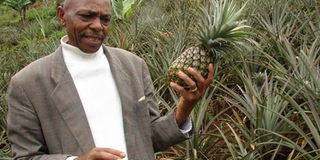I pick my sh38,000 salary every month from pineapples

David Mburu in his Igamba pineapple farm, in Gatundu North, Kiambu. Pineapple is his main crop, having started with some 200 suckers, but now has 4, 000 plants on half-acre. PHOTO | WAIKWA MAINA | NMG
What you need to know:
- Pineapple is his main crop, having started with some 200 suckers, but he now has 4, 000 plants on half-acre.
- The crop can grow in almost all types of soils with an annual average rainfall of 500mm.
- Every week, Mburu harvests between 100 and 120 pineapple fruits from the half-acre, selling each selling at Sh100.
At the gate of David Mburu’s farm in Gatundu North, one is welcomed by flourishing well-tended passion fruits, intercropped with sukuma wiki and some indigenous vegetables.
Next to the farm is a heap of plant materials for compost making and a cowshed from where slurry is directed to a section of the farm hosting tomato plants and fruit trees of Hass avocado, bananas and macadamia trees. But the most visible are the pineapple stems on half-acre.
“I started the farm in 2013 to train my neighbours on organic farming and value addition skills I had gained while in prison, but none wanted to associate with me. I gave up and chose to farm on my own,” says the former police officer.
Pineapple is his main crop, having started with some 200 suckers, but he now has 4, 000 plants on half-acre.
With earnings from the mixed farm, Mburu has bought an acre where he now lives with the family and heavily invested in the pineapples.
“Pineapples have a ready market and are easy to manage through organic farming.” To plant, the farmer ploughs the farm twice reaching a 30cm depth.
He then makes holes of a feet deep and 15cm in diameter, plants the suckers and fills the hole with a mixture of soil and well-prepared compost manure, with half-acre taking four tonnes.
“I have never encountered disease or pests challenges, so the only major cost is land preparation and weeding, which is done twice a month and later once a month as the plants grow. I spent between Sh2,000 to Sh3,000 on manure.”
INVEST IN JUICE MAKING
Muthike Mbiri, an agricultural officer with Rodi-Kenya, which trained Mburu and other inmates at Nairobi West Prison, says for maximum production, the recommended spacing for pineapples is at 30cm between plants and 45 to 60cm between rows.
“This will give a farmer between 50 and 70 tonnes of pineapple per acre,” says the agronomist. For healthy plants, Mbiri says a farmer should maintain a maximum of three suckers per plant throughout the season.
He adds that the crop can grow in almost all types of soils with an annual average rainfall of 500mm.
They can grow in almost any part of the country, from coastal region to highlands, but the climate and weather partners determine the flowering period, where coastal region records early flowering at eight months compared to 12 months in other regions,” says Mbiri.
Every week, Mburu harvests between 100 and 120 pineapple fruits from the half-acre, selling each selling at Sh100.
“I have a contract with a buyer who comes for 60 pieces which I pack in dozens, I sell the surplus to local consumers where I get even better returns at between Sh120 to Sh150 depending on size,” says the farmer.
The contract between Mburu and his buyer guarantees him Sh38,400 every month, enabling him to comfortably educate his four children, two in university and others in secondary schools.
His dream is to increase the acreage to about five acres then invest in juice making equipment.
With proper agronomy, Mbiri says the crop can be harvested up to seven years when it’s uprooted and a new generation introduced.





